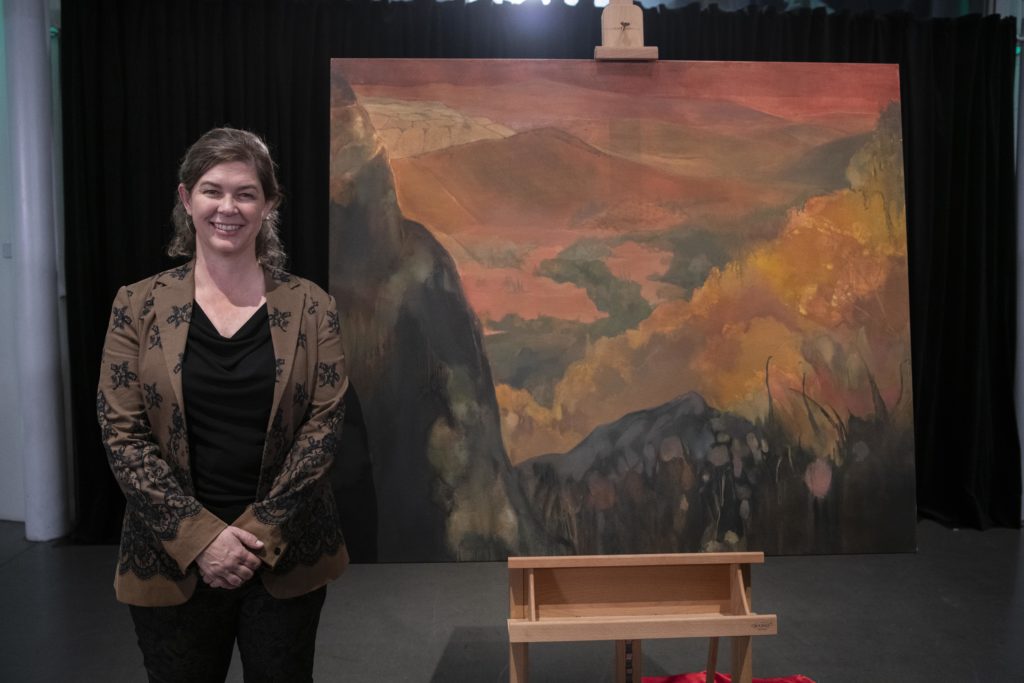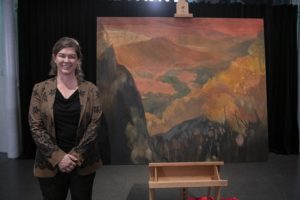When I talk to people about the competition I often start by saying its been a “rollercoaster ride” (which is very funny as my entry to the competition was a painting of a rollercoaster). The rollercoaster feeling kicked in more strongly following my win at Greenwich. The prize was a trip to Macedonia to paint a commission for the Imperial War Museum, commemorating a long-forgotten battle of the First World War.
This presented me with a big problem – a massive fear of flying that meant I hadn’t flown in 10 years. Weirdly, I had already decided to tackle this long-standing fear as I had already accepted some work in Prague and flying was the only option. My lovely cousin Vicky kindly paid for me to attend a fear of flying course, which was booked for the middle of September. Little did I know that I would need to fly for a very different reason. After winning the final, I cancelled my work trip to Prague, knowing that I now had to fly to Greece. Thankfully the course was a brilliant success and I approached the trip to Macedonia confident that the flying was doable and decided to keep my fears secret from the crew.
Then rollercoaster did its thing again! A couple of days before we flew out, I injured my back to the point that I could not walk more than 5 metres. I visited the chiropractor and got some major meds for my back, but still had to be transported onto the airplane in a wheelchair. My fear of flying didn’t get a look in as I crawled onto the plane and was quickly moved to the front where I had a whole row of seats to myself – result! Upon landing in Thessaloniki, my first job was to visit an Osteopath my friend had recommended then take a taxi to the beach so I could at least have a little swim before the work of painting and filming kicked in.
Considering we were only away for five or six days we did so much. This included exploring Thessaloniki port and the old town, meeting Alan Wakefield IWM and Salonika Front expert, visiting the church at Smol which Stanley Spencer used in his Travoys painting, being denied entry into Macedonia (!), attending a memorial service at the Dioran Memorial with the Duke of Kent, meeting with family and friends of the Salonika society, travelling to Rocky Peak and Kosturino ridge on a tractor trailer and so many other things! After the Greenwich final I remember thinking “last years winner went to Jamaica and it’s sandy beaches, and I’m going to a battlefield!” but I have to say that this was quickly replaced by a genuine interest in the Salonika front, the stories, the people and the life of Stanley Spencer. It was such a rich mix of history, geography, art and humanity that I quickly connected with the job at hand and all the possibilities for the commission.
A photo diary
There were many opportunities to draw and paint, starting with the port and a quick charcoal sketch of the white tower across the bay.
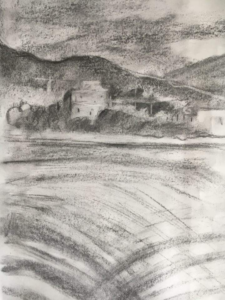
Later that day we travelled to the heights of Thessaloniki and I painted the view of the city and out to sea. Thankfully the competition prepared me for some very fast painting and during this trip and I often only had an hour or so to produce something!
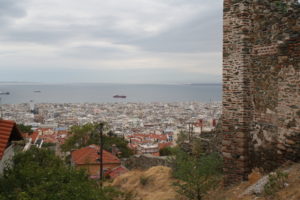
You can see this little painting in the photo of all the paintings I completed (so far) from Macedonia.
After the memorial service I explored the lake at Dioran and produced a rather dark image of the lake and dead trees. I loved this place – it was eerie but had so many things to explore in terms of the psyche of the landscape.
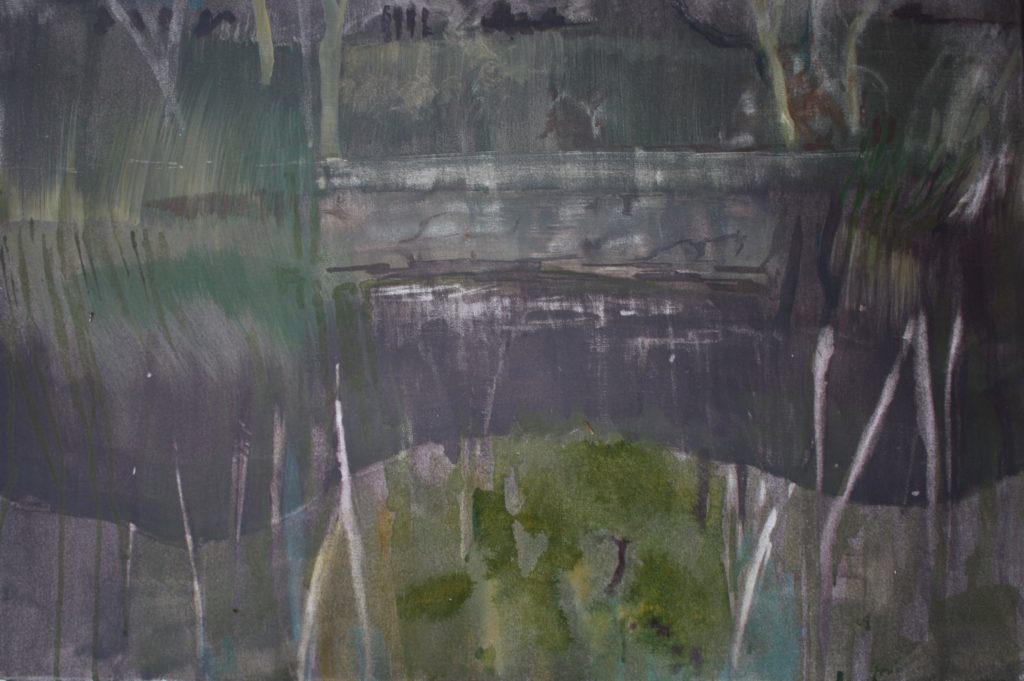
On the last day we travelled to Rocky Peak. I was so over-excited to go in the tractor trailer and we sung songs on the way up which took about an hour of bumping around (my back reminded me of its presence!)
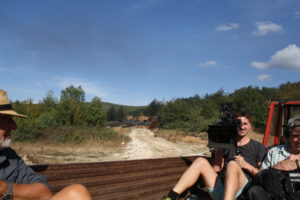
During the journey I was also intrigued by the prevalence of illegal, small lime kiln furnaces. They are fuelled by burning car tyres which produce thick black smoke. Once abandoned, these kilns leave deep, circular holes in the earth.
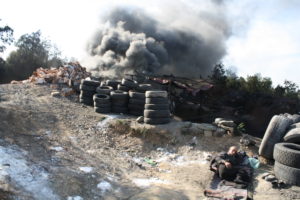
Weirdly these kiln fires produced pockets of smoke which floated across the landscape and they reminded me of the fires which would have proliferated the hills during the war.
Rocky Peak
The view from Rocky Peak was stunning. We arrived around 5pm with the sun quickly fading and I set to work on a triptych of paintings, under painted in red, for some reason. I think I was a little grumpy as we only had an hour to paint before we lost the light and I was in a bit of a mood. For some reason I grabbed red and whacked it over all three canvasses. It only occurred to me later how this red could have easily represented the blood shed in this place. It wasn’t a conscious decision, but I think it worked. You can see the red triptych in the group photo at the end o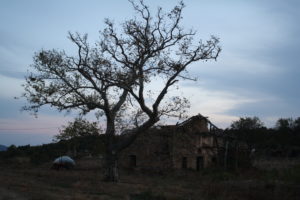 f this piece.
f this piece.
Briefly, the battle of Rocky Peak was fought in early December 1916 with the Allies holding the Peak but being attacked from below and behind by the Bulgarians. It was a battle that was probably not winnable and over 700 men lost their lives in the space of a couple of days – their bodies were never recovered.
Something else I found fascinating about the war fought at this place was the abandoned village of Ornali. Which was situated on the edge of the front. Alan told me that after it was abandoned, the allies and central forces, took turns to share the use of the village! They would take turns to use it to dry out clothes, get warm, cook etc. A shared resource during the most bitter of wars. This fascinated me and given time, I would have explored this further.
Moving studio!
Returning from such a busy and exciting trip to such an interesting place rendered me exhausted for a couple of days, but I spent the time printing photos and priming canvases. I also had to wait until the time-lapse camera was set up in my studio before I could start painting in earnest. By Friday I was ready to start and had just three weeks to complete the commission (consider that against the 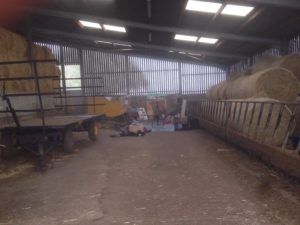 great war artists who had months and years to complete their work!) The deep red underpainting that had emerged at Rocky Peak was a must and it was the first thing I did in my little studio space in Thornbury. By the end of the day I realised that I couldn’t work in that studio – I just didn’t have enough room. I had decided to make my main painting on a largish (140x160cm) chunky canvas – anything smaller felt it would not do justice to the subject matter.
great war artists who had months and years to complete their work!) The deep red underpainting that had emerged at Rocky Peak was a must and it was the first thing I did in my little studio space in Thornbury. By the end of the day I realised that I couldn’t work in that studio – I just didn’t have enough room. I had decided to make my main painting on a largish (140x160cm) chunky canvas – anything smaller felt it would not do justice to the subject matter.
In a panic I rang the director to say I needed to move studio and then rang a farmer friend who I knew had an empty cow shed for the next couple of weeks. I decided to move in, which shortened my painting time by another 3 days! However, it was the right move – I loved the cow shed immediately and recommenced work on the commission and also started another 3 paintings. Shortly after moving into the cow shed, the director rang me and told me about the weird coincidence that Stanley Spencer had also had to move into a cow shed to complete his Travoys painting – strange eh?
Time-lapse painting
The weather was kind and was actually nice and warm (about 20 degrees) for the first 10 days after which it started to plummet, and I dug out my padded boiler suit. By the time I finished it was barely above freezing and I had a hot water bottle down my boiler suit.
The main commis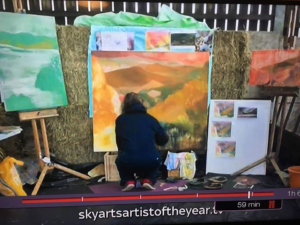 ion progressed well with the usual wrangling that occurs during a large piece of work. You can see it at an earlier stage in the photo below. Something I wanted to do in the painting was to bring texture and shape to what was quite a flat, green hillside. I also wanted to feature local foliage strongly to give it a sense of place. The rocks of Rocky Peak frame the view strongly and eventually turned dark after much consideration. The foreground features cotton plants which are grown locally, but they also seem to resemble heads and faces maybe? In the background you will see some ghosts of the landscape from the war. The fields were stripped of trees back then and you can see the shapes of the barren fields. Top left, if you look carefully, there is a red star, well planet actually – Mars, no longer the bringer of war, which was very clear in the sky this summer.
ion progressed well with the usual wrangling that occurs during a large piece of work. You can see it at an earlier stage in the photo below. Something I wanted to do in the painting was to bring texture and shape to what was quite a flat, green hillside. I also wanted to feature local foliage strongly to give it a sense of place. The rocks of Rocky Peak frame the view strongly and eventually turned dark after much consideration. The foreground features cotton plants which are grown locally, but they also seem to resemble heads and faces maybe? In the background you will see some ghosts of the landscape from the war. The fields were stripped of trees back then and you can see the shapes of the barren fields. Top left, if you look carefully, there is a red star, well planet actually – Mars, no longer the bringer of war, which was very clear in the sky this summer.
I also started several other paintings during my time in the cow shed, managing to complete two of them. I am pleased with this one in particular. Whilst it was not at all foggy when we were up Rocky Peak, it was very foggy on the morning of the battle in December 1916. I took inspiration from a painting by Casper David Friedrich and created an imagined view from Rocky Peak in thick fog.
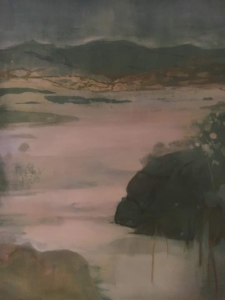
If you would like to see the final painting, it is now on display at the Imperial War Museum Manchester.
